Sound: 









Value: 









(Read about our ratings)
 At the start of my college career in 2001, I became heavily involved in road cycling. Every day I would spend hours riding my road bike, captivated by the solitude of the climbs in California’s Santa Monica mountains. I was far from a natural climber; I was just too heavy, with too little threshold power. But I loved the long climbs for two distinct reasons: the long, fast descents, and the sense of focus enabled by my Apple earbuds and first-generation iPod. High fidelity was not the goal; having 1000 songs at the touch of a button was. The music provided the fuel that no carbohydrate gel could match, and earbuds were the key.
At the start of my college career in 2001, I became heavily involved in road cycling. Every day I would spend hours riding my road bike, captivated by the solitude of the climbs in California’s Santa Monica mountains. I was far from a natural climber; I was just too heavy, with too little threshold power. But I loved the long climbs for two distinct reasons: the long, fast descents, and the sense of focus enabled by my Apple earbuds and first-generation iPod. High fidelity was not the goal; having 1000 songs at the touch of a button was. The music provided the fuel that no carbohydrate gel could match, and earbuds were the key.
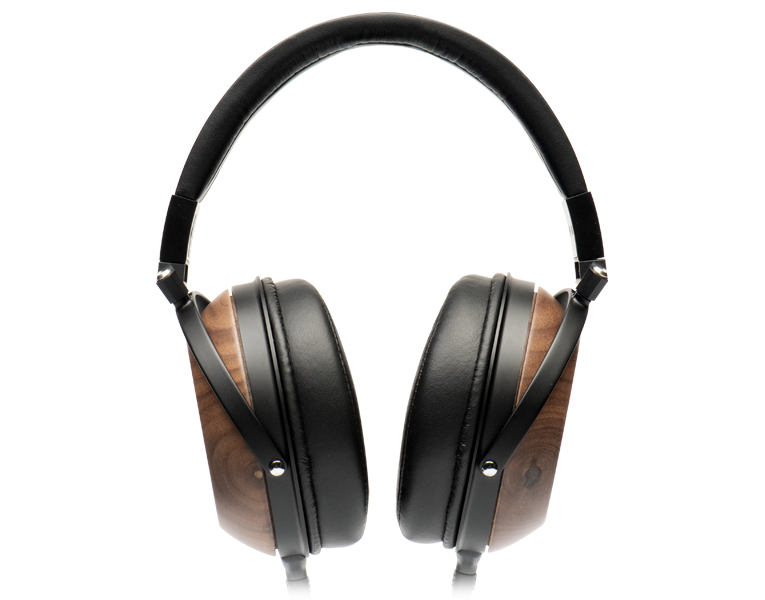
My college days are far behind me, and my cycling expeditions are less frequent. But music is still the fuel for my daily tasks, which include countless hours at a desk in front of a computer. AAC files on an iPod will no longer satisfy. Now I listen to FLAC and DSD files through serious head-fi setups comprising audiophile headphones, headphone amps, and USB DACs.
Description
Enter the brand-new TH616 headphones from Japan’s Fostex ($1299.95, all prices in USD). My review sample arrived in a single shipping box, with the inner box housing the headphones wrapped in clear plastic. The urge to connect the cables and begin listening immediately was strong, but I resisted. I took inventory of the box, then read the manual. The next step was figuring out whether the box was going to flip or slide open—it was the latter. A new-car smell came wafting out of the box with the contents individually wrapped in clear plastic: the manual, headphones, detachable cable with 6.35mm (1/4″) stereo plug, and leather carrying bag.
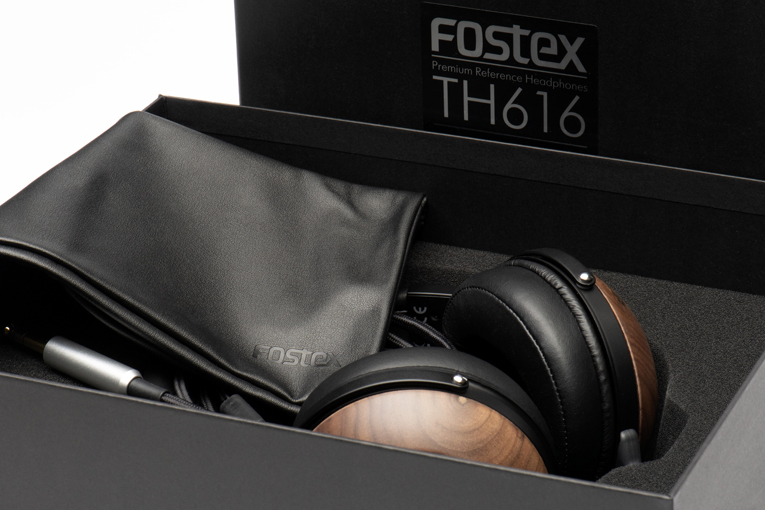
The Fostex TH616s are open-back dynamic headphones employing 50mm drivers with powerful neodymium magnets and Fostex’s BIODYNA diaphragms. Also used in Fostex’s flagship TH909 headphones, BIODYNA is an “ultra-fine bio-cellulose fiber material” said to have “a low specific gravity [dimensionless unit of measurement for density in relation to the density of water], high Young’s modulus [stiffness of material], and high internal loss.” The motor system features an ultra-strong 1-Tesla magnetic circuit “to create an expansive dynamic range with ultra-low distortion.” Specified frequency response is 5Hz–45kHz. With 25-ohm impedance and 96dB/mW sensitivity, the TH616s should be easy to drive. Rated power handling is 1800mW.
Designed to commemorate Fostex’s 50th anniversary, the TH616s are hand-built in Japan. These are beautiful headphones with a premium feel and premium materials. They warrant display in a prominent location. And compared to my reference Audeze LCD-2 Closed-Back headphones ($899), they’re light. The Fostex ’phones weigh 370gm; my Audezes, 612gm.
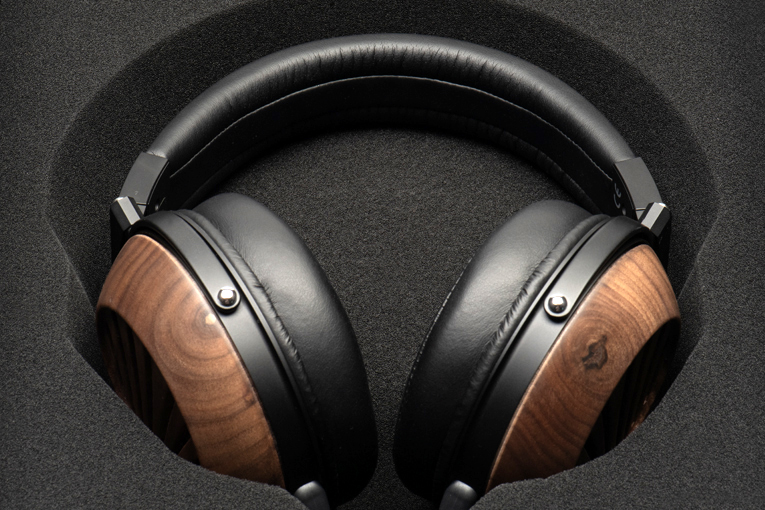
The TH616s’ earcups are hand-milled from solid black walnut and feature carved openings that Fostex says draw “inspiration from the captivating natural phenomenon where sunlight produces a radiant glow as it filters through the spaces amidst trees.” Fostex says the TH616s’ striking design also has sonic benefits. “This precision-machined design not only upholds structural rigidity but also effectively eliminates the generation of modal vibrations. Each opening is meticulously sized to prevent resonance at particular frequencies.”
Aluminum is used throughout for mechanical components to provide a premium feel and low weight. Just like my road-racing machine, keeping the weight low was only part of the equation. High-specific-gravity resin is used on the baffle plates, which “effectively minimizes resonance noise, resulting in exceptional resolution, a lush mid-range, and high-quality bass reproduction.”
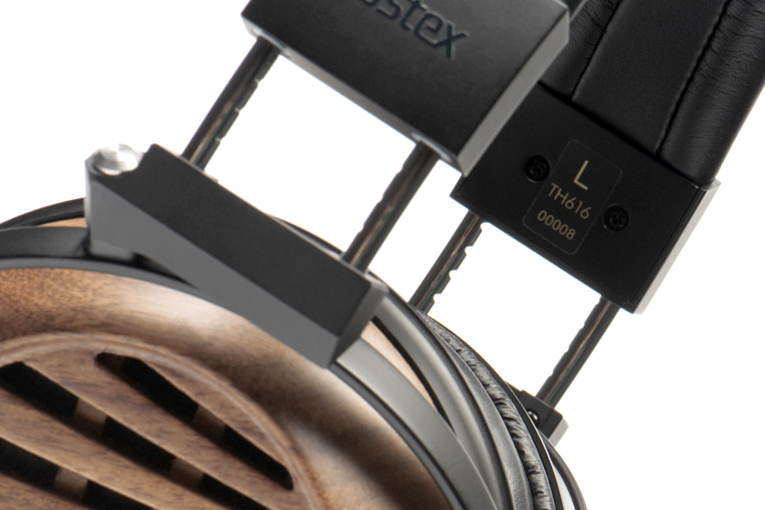
The supplied 3m (9.84′) cable connects to each earcup via a rhodium-plated two-pin connector with a gold-plated base. This construction “enhance[s] hardness, abrasion resistance, and corrosion resistance, ultimately boosting their reliability,” Fostex claims. The cable’s conductors are fashioned from a high-purity copper (99.99999% oxygen free) called HiFC, supplied by Hitachi Metals, Ltd. HiFC is “enhanced through specialized processing to ensure impeccable conductivity, enabling a precise rendition of the full spectrum of bandwidth.” The cable is extremely well made; I experienced no microphonics or bunching. A balanced cable terminating in an XLR connector is available separately for $299.99.
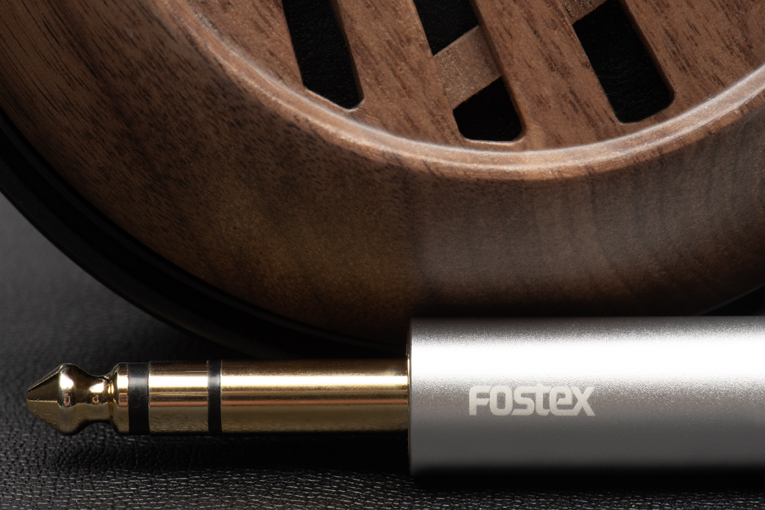
The aluminum headband has low clamping force. Combined with the low weight and the cushioned earcups, which are covered with artificial leather, this made for very comfortable listening sessions.
Setup
I do most of my headphone listening in a desktop environment, so component size is a huge factor. I am running a Chord Qutest DAC connected by single-ended Shunyata Research Venom RCA interconnects to a Rupert Neve Designs RNHP Precision headphone amplifier. A Raspberry Pi 4 acts as the Roon endpoint streamer and the server is an Innuos Zen Mk3. This was the baseline setup that I was familiar with, and I was wary of introducing too many new components at once. A few weeks into the review I introduced another headphone amplifier, the Bryston BHA-1 (review pending). A Shunyata Research Venom HC power cord was used to power the Bryston headphone amplifier.
Sound
My first impressions of the Fostex TH616s’ sound can be summed up in a single phrase: an effortless sense of ease, combined with speed and punch. The instruction manual said nothing about a break-in period, but I wanted to do a week or so of casual listening before any critical listening.
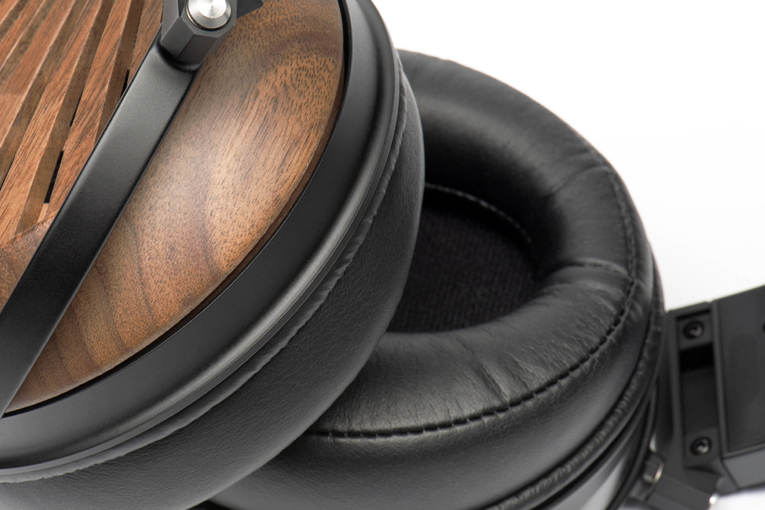
Most of my headphone listening takes place in the evenings after long days. A great way to settle down is with slower ambient-type music, such as “Song Of Ruth” by the Bobo Stenson Trio from their album Cantando (24-bit/44.1kHz MQA, ECM Records / Tidal). The soundstage on this recording is wide and expansive with the right equipment. Fed by my Chord Qutest DAC and Rupert Neve headphone amplifier, the TH616s delivered a deep soundstage with sound emanating from behind my ears, giving me the impression that the music was coming from behind me. Several times, this caused me to turn around in my seat to see if my partner and newborn needed me. The sound was enveloping and featured a wide soundstage sweeping across the right and left channels with extreme delicacy and crispness.
Wanting to hear whether a more powerful headphone amplifier would improve the TH616s’ performance, I replaced the Rupert Neve amplifier with the Bryston BHA-1 and replayed “Song Of Ruth.” I heard a marked improvement in detail and scale. The very good Rupert Neve driving the Fostex TH616s suddenly seemed like 720p video, while the Bryston was 4K! The instrument separation was greater and more defined. The Fostex TH616s will scale up with better amplification, which means they would be a perfect pair of headphones for those just starting out.
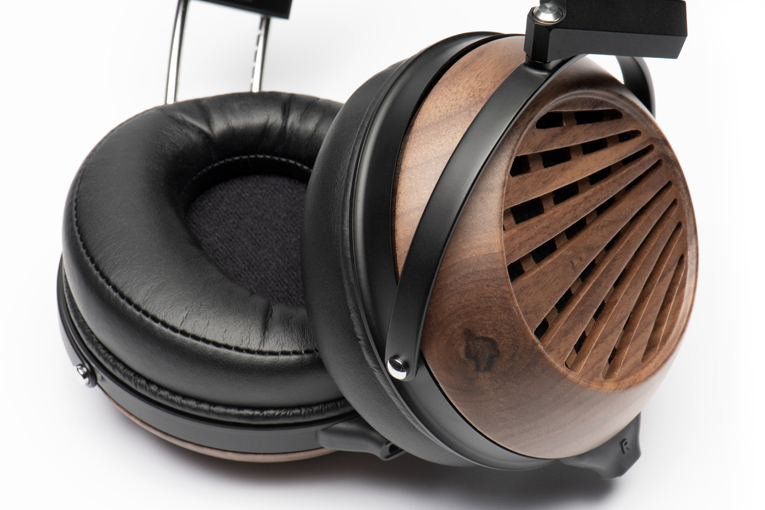
“Storm Before the Calm” from What Kinda Music by Tom Misch & Yussef Dayes (24/44.1 MQA, Beyond the Groove—Blue Note Records / Tidal) is a complex piece featuring a guest appearance by saxophonist Kaidi Akinnibi. The piece begins with Dayes’s veiled but strong drum section in the front and center, before a DJ-type fade at the one-minute mark completely lifts the veil on Akinnibi’s brilliant saxophone. Through the TH616s the sound was quick and impactful, with no thoughts of insufficient bass coming from the drums. The bass was deep and textured, reminding me of when I played drums myself in my youth. The Bryston BHA-1 did a wonderful job of controlling the bass and impact, giving me a sense that I was listening through loudspeakers. Another aspect of “Storm Before the Calm” that I love is the presentation of the soundstage. Because of my experience with drums in the past, my ears key in on the bass drum, snare, and hi-hat. Akinnibi’s saxophone is the most prominent feature of the song, but I was easily able to pick out the sounds of the individual drum components. I was particularly impressed with the decay of the crash and ride cymbals.
Comparisons
Bob Dylan’s “Man in the Long Black Coat” from his 1989 album Oh Mercy (24/96 FLAC, Columbia Records / Qobuz) is an audiophile staple. Through the TH616s, the plucked guitar strings had clearly defined edges with lush texture; notes on the lower strings sounded deep and full. When I switched to my Audeze LCD-2 Closed-Back reference ’phones, the first thing I noticed was a more laid-back sound. The highs were rolled off; the bass was more polite, less defined, and less forward in presentation. The interesting thing is the Audeze LCD-2 Closed-Back headphones are known for their great bass. But while the Audezes sounded warmer, the TH616s delivered more punch and low-frequency detail. I was disappointed in how my reference headphones compared to the TH616s on this song, but then I remembered Roon’s MUSE DSP settings, which include custom filters and crossfeed settings for Audeze headphones. When I enabled Roon’s Audeze filters, the highs opened up. Guitar notes were crisper, with slightly more textured bass. The midrange became more coherent. But the Fostex ’phones still outperformed my beloved Audezes, even with Roon’s help.
In my office, I use Sennheiser HD 6XX headphones ($199) with balanced cables. My plan was to compare them to the TH616s because they’re both open-back headphones—plus I got to play with the balanced outputs of the Bryston BHA-1. There is a big price difference between these two sets of headphones, but my thinking was their balanced connection might tip the scales toward the Sennheisers, as they would receive the BHA-1’s full 4W of class-A power. I was wrong! Even though I was using a single-ended connection for the Fostex headphones, the Sennheisers were completely outclassed. The highs were bright and harsh in comparison, even at low volume settings. The bass was more anemic. The midrange of the Sennheisers was pleasant, but the distraction of the higher level of distortion in the highs was something that could not be ignored.
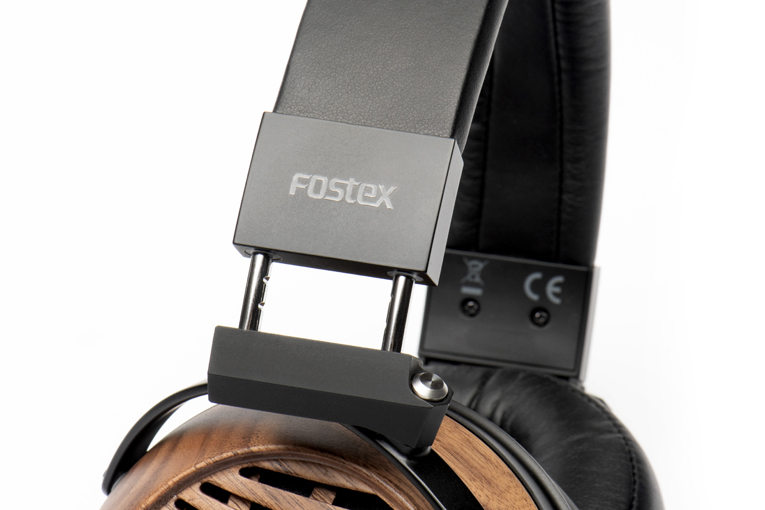
Finally, I listened to one of my favorite R&B albums, ((( 1 ))) by ((( O ))) (16/44.1 FLAC, ((( O ))) / Tidal). I’m not exactly sure how to pronounce the artist’s name, but her music is amazing. “Shuh Shuh” begins with the sound of rain in the background and the smooth melodic voice of ((( O ))) supported by piano chords. The bass kicks in strong, digging deep, akin to a bass test track of the 1990s. This time I started with the Audezes, then switched to the Fostex TH616s; I immediately realized the volume was too high. They’re very sensitive, and don’t need much juice to play at ear-ringing volumes. Once I had level-matched the two pairs of headphones, I noticed that the TH616s had removed a veil that I wasn’t aware of when listening through the Audezes. For example, where the track begins with the sound of rain, through the Fostex ’phones I now heard the rainwater pooling and flowing. The presentation was lightning-fast and controlled. The entire presentation was front and center with dynamics that emerged effortlessly. On “Nature’s Joint” from the same album, I heard birdsong effects in the background of the vocals that I’d not been previously aware of.
Conclusion
The Fostex TH616s are ultra-revealing audiophile headphones with detailed, extended highs and deep, textured bass. This held true with each of the two amplifiers that I used. With these headphones, I recommend paying close attention to front-end components. Whatever is fed into the Fostex TH616s will be faithfully reproduced. I found myself choosing a warmer filter on my Chord Qutest when listening to more poorly mastered recordings. Every genre I tried was a great pleasure because I was hearing nuances I did not know the tracks I was auditioning contained. The combination of great sound, low weight, gentle clamping force, and comfortable earpads made me want to keep on listening, song after song, album after album.
. . . Killain Jones
Associated Equipment
- Headphone amplifiers: Rupert Neve Designs RNHP Precision, Bryston BHA-1.
- Headphones: Audeze LCD-2 Closed-Back, Sennheiser HD 6XX.
- Server: Innuos Zen Mk3.
- Streamer: Raspberry Pi 4.
- DAC: Chord Electronics Qutest.
- Cables: Shunyata Research Venom (RCA).
- Power distributor/conditioner: Audioquest PowerQuest 3.
- Power cord: Shunyata Research Venom HC (for Bryston BHA-1).
Fostex TH616 Headphones
Price: $1299.95.
Warranty: One year.
Fostex Company
A division of Foster Electric Co., Ltd.
1-1-109 Tsutsujigaoka, Akishima City
Tokyo, 196-8550, Japan
Phone: +81 42 545 6111
Fax: +81 42 546 6067
Website: www.fostexinternational.com
US distributor:
American Music & Sound—An Exertis | JAM business
310 Newberry Rd.
Bloomfield, CT 06002-9005
Phone: 1-800-431-2609
Website: www.americanmusicandsound.com
Canadian distributor:
Erikson Consumer—An Exertis | JAM business
Baie-D’Urfé, Quebec H9X 4B7
Phone: 1-800-567-3275
Website: www.eriksonconsumer.com




